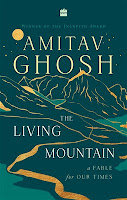Book Review: The Living Mountain: a Fable for Our Times by Amitav Ghosh
 |
“Their savants had studied all that was told to their envoy, and they were convinced that unbeknownst to us, great riches-minerals, metals and the like- were hidden within the mountain. We were unaware of this because we were a credulous and benighted people, who believed our Mountain was alive. The savants of the Anthropoi were unmatched in their wisdom and they decided that since we were not making any use of the mountain’s riches, they were fully justified in seizing them and taking whatever they wished.”
What follows is a series of events that begins with the subjugation of the indigenous population by the Anthropoi and exploitation of natural resources, and ultimately lead to revolt, infighting, and destruction brought on by the utter disregard for the consequences of the actions of man against nature.
“How dare you speak of the Mountain as though you were its masters, and it were your plaything, your child? Have you understood nothing of what it has been trying to teach you? Nothing at all?”
Amitav Ghosh’s “The Living Mountain: a Fable for Our Times” is an exquisitely written story that packs a punch in its 35 pages. Deceptively simple with folk-tale-like elements and descriptions, this allegory can be interpreted as a cautionary tale as well as a simplistic yet vivid depiction of colonialism, climate change, exploitation of man and nature, and the far-reaching effects of commercialism and abuse of natural resources fueled by the greed and avarice of men. This is a tale for everyone with so much depth in what is such a timely and relevant little story. I wish it were longer than 35 pages. The simple black and white illustrations by Devangana Dash that accompany the prose are quite lovely. This is a book meant to be read , reread, shared and talked about.
I was fortunate to get my hands on the audiobook which I listened to after reading the story a couple of times and I must commend the narrators, Pallavi Bharti and Ranjit Madgavkar for their mesmerizing rendition of this story.
Comments
Post a Comment